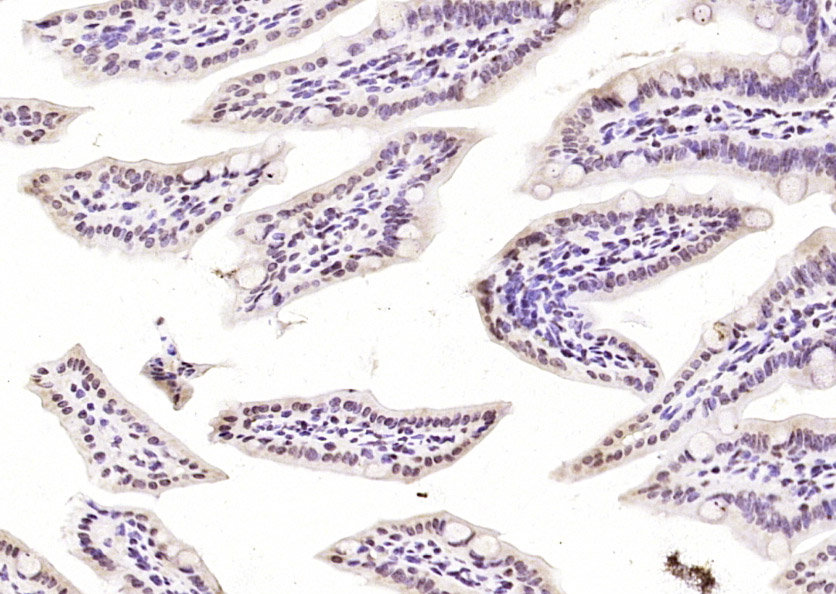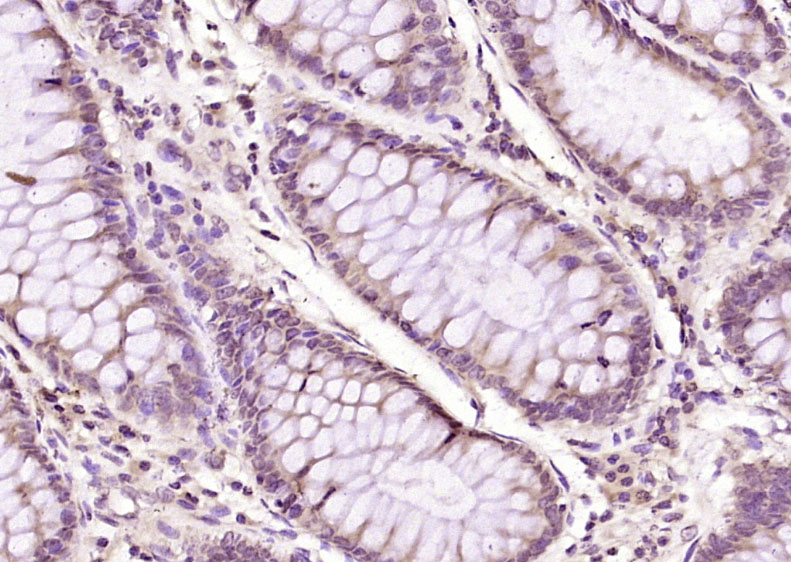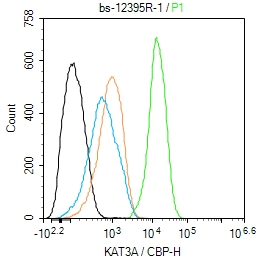
Rabbit Anti-KAT3A / CBP antibody
CBP; CBP_HUMAN; CREB binding protein; CREB-binding protein; CREBBP; Cyclic AMP responsive enhancer binding protein; Cyclic AMP-responsive enhancer binding protein; KAT3A; RSTS; RTS; Rubinstein Taybi syndrome; Rubinstein-Taybi syndrome.
View History [Clear]
Details
Product Name KAT3A / CBP Chinese Name CREBBinding protein抗体 Alias CBP; CBP_HUMAN; CREB binding protein; CREB-binding protein; CREBBP; Cyclic AMP responsive enhancer binding protein; Cyclic AMP-responsive enhancer binding protein; KAT3A; RSTS; RTS; Rubinstein Taybi syndrome; Rubinstein-Taybi syndrome. Research Area Tumour Cell biology immunology Chromatin and nuclear signals Signal transduction Binding protein The new supersedes the old Immunogen Species Rabbit Clonality Polyclonal React Species Human, Mouse, (predicted: Rat, Chicken, Dog, Pig, Cow, Horse, Sheep, ) Applications ELISA=1:5000-10000 IHC-P=1:100-500 IHC-F=1:100-500 Flow-Cyt=1ug/Test IF=1:100-500 (Paraffin sections need antigen repair)
not yet tested in other applications.
optimal dilutions/concentrations should be determined by the end user.Theoretical molecular weight 265kDa Cellular localization The nucleus cytoplasmic Form Liquid Concentration 1mg/ml immunogen KLH conjugated synthetic peptide derived from human KAT3A/CBP: 301-400/2442 Lsotype IgG Purification affinity purified by Protein A Buffer Solution 0.01M TBS(pH7.4) with 1% BSA, 0.03% Proclin300 and 50% Glycerol. Storage Shipped at 4℃. Store at -20 °C for one year. Avoid repeated freeze/thaw cycles. Attention This product as supplied is intended for research use only, not for use in human, therapeutic or diagnostic applications. PubMed PubMed Product Detail Cyclic AMP-regulated gene expression frequently involves a DNA element designated the cAMP-regulated enhancer (CRE). Many transcription factors bind to this element, including the protein CREB, which is activated as a result of phosphorylation by protein kinase A. It has been shown that protein kinase A-mediated CREB phosphorylation results in its binding to a nuclear protein designated CBP (for CREB-binding protein). These findings suggest that CBP has many of the properties expected of a CREB co-activator. Another high molecular weight transcriptional adapter protein, designated p300, is characterized by three cysteine- and histidine-rich regions, of which the most carboxy terminal region specifically binds the adenovirus E1A protein. p300 molecules lacking an intact E1A binding site bypass E1A repression, even in the presence of high concentrations of E1A. Sequence analysis of CBP and p300 has revealed substantial homology, arguing that these proteins are members of a conserved family of co-activators.
Function:
Acetylates histones, giving a specific tag for transcriptional activation. Also acetylates non-histone proteins, like NCOA3 coactivator. Binds specifically to phosphorylated CREB and enhances its transcriptional activity toward cAMP-responsive genes. Acts as a coactivator of ALX1 in the presence of EP300.
Subunit:
Found in a complex containing NCOA2; NCOA3; IKKA; IKKB and IKBKG. Probably part of a complex with HIF1A and EP300. Interacts with GATA1; the interaction results in acetylation and enhancement of transcriptional activity of GATA1. Interacts with MAF AND ZCCHC12. Interacts with DAXX; the interaction is dependent on CBP sumoylation and results in suppression of the transcriptional activiy via recruitment of HDAC2 to DAAX (By similarity). Interacts with phosphorylated CREB1. Interacts with CITED4 (C-terminal region). Interacts (via the TAZ-type 1 domain) with HIF1A. Interacts with SRCAP, CARM1, ELF3, MLLT7/FOXO4, N4BP2, NCOA1, NCOA3, NCOA6, PCAF, DDX5, DDX17, PELP1, PML, SMAD1, SMAD2, SMAD3, SPIB and TRERF1. Interacts with HTLV-1 Tax and p30II. Interacts with HIV-1 Tat. Interacts with KLF1; the interaction results in acetylation of KLF1 and enhancement of its transcriptional activity. Interacts with MTDH. Interacts with NFATC4. Interacts with MAFG; the interaction acetylates MAFG in the basic region and stimulates NFE2 transcriptional activity through increasing its DNA-binding activity. Interacts with IRF2; the interaction acetylates IRF2 and regulates its activity on the H4 promoter. Interacts (via N-terminus) with SS18L1/CREST (via C-terminus). Interacts with MECOM. Interacts with CITED1 (via C-terminus). Interacts with FOXO1; the interaction acetylates FOXO1 and inhibits its transcriptional activity.
Subcellular Location:
Cytoplasm. Nucleus. Recruited to nuclear bodies by SS18L1/CREST. In the presence of ALX1 relocalizes from the cytoplasm to the nucleus.
Post-translational modifications:
Methylation of the KIX domain by CARM1 blocks association with CREB. This results in the blockade of CREB signaling, and in activation of apoptotic response.
Phosphorylated upon DNA damage, probably by ATM or ATR.
Sumoylation negatively regulates transcriptional activity via the recruitment of DAAX.
DISEASE:
Note=Chromosomal aberrations involving CREBBP may be a cause of acute myeloid leukemias. Translocation t(8;16)(p11;p13) with MYST3/MOZ; translocation t(11;16)(q23;p13.3) with MLL/HRX; translocation t(10;16)(q22;p13) with MYST4/MORF.
MYST3-CREBBP may induce leukemia by inhibiting RUNX1-mediated transcription. Defects in CREBBP are a cause of Rubinstein-Taybi syndrome type 1 (RSTS1) [MIM:180849]. RSTS1 is an autosomal dominant disorder characterized by craniofacial abnormalities, broad thumbs, broad big toes, mental retardation and a propensity for development of malignancies.
Similarity:
Contains 1 bromo domain.
Contains 1 KIX domain.
Contains 2 TAZ-type zinc fingers.
Contains 1 ZZ-type zinc finger.
SWISS:
Q92793
Gene ID:
1387
Database links:Entrez Gene: 1387 Human
Entrez Gene: 12914 Mouse
Omim: 600140 Human
SwissProt: Q92793 Human
SwissProt: P45481 Mouse
Unigene: 459759 Human
Unigene: 132238 Mouse
Unigene: 392384 Mouse
Unigene: 12815 Rat
Product Picture
Primary Antibody (green line): Rabbit Anti-KAT3A/CBP antibody (SL12395R)
Dilution: 1ug/Test;
Secondary Antibody : Goat anti-rabbit IgG-FITC
Dilution: 0.5ug/Test.
Protocol
The cells were fixed with 4% PFA (10min at room temperature)and then permeabilized with 90% ice-cold methanol for 20 min at -20℃.The cells were then incubated in 5%BSA to block non-specific protein-protein interactions for 30 min at room temperature .Cells stained with Primary Antibody for 30 min at room temperature. The secondary antibody used for 40 min at room temperature. Acquisition of 20,000 events was performed.
Bought notes(bought amounts latest0)
No one bought this product
User Comment(Total0User Comment Num)
- No comment





 +86 571 56623320
+86 571 56623320
 +86 18668110335
+86 18668110335

